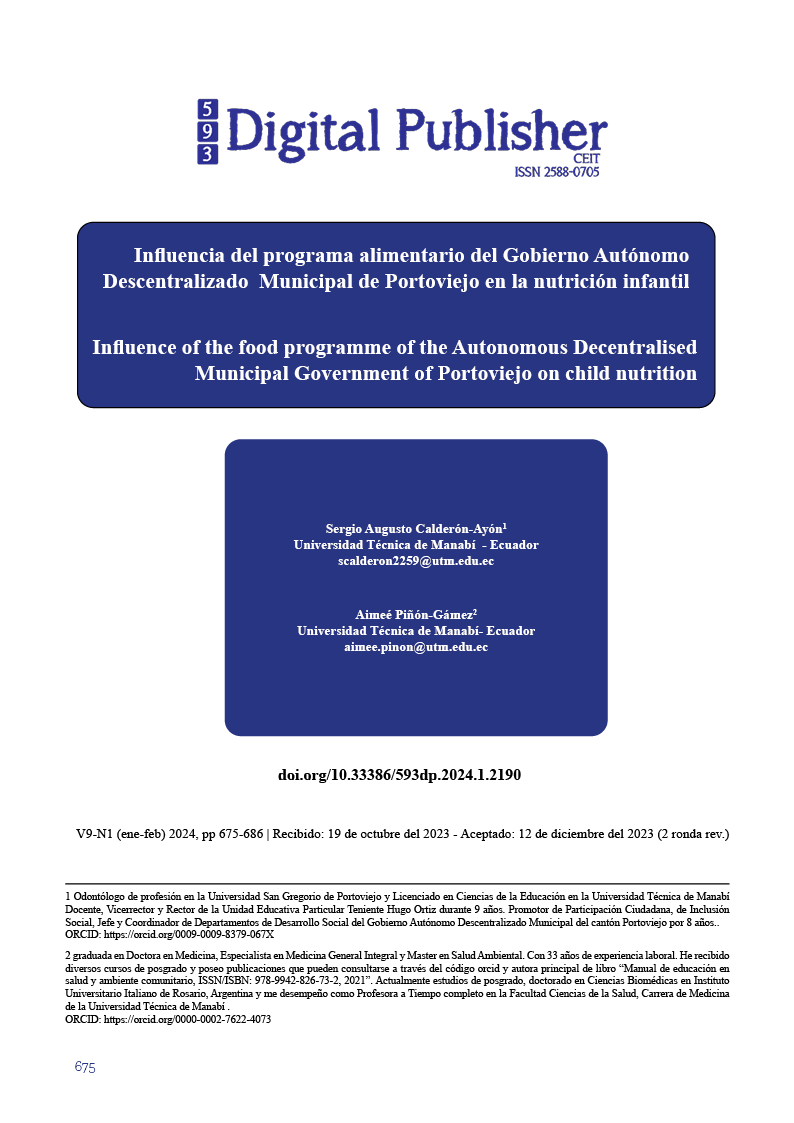Influence of the Food Programme of the Autonomous Decentralised Municipal Government of Portoviejo on Child Nutrition
Main Article Content
Abstract
The objective of the research, which focuses on evaluating the influence of the food program of the Municipal Decentralized Autonomous Government of Portoviejo on the nutritional situation of children, in the Andrés de Vera parish. Through an observational, descriptive, and cross-sectional research methodology where only one measurement will be taken to collect the information, with a qualitative-quantitative approach. Taking as population and sample legal representatives of children who are part of this feeding program. In turn, the technique and data collection tool used is based on a questionnaire that contains the study variables: risk factors, nutritional status, complementary feeding practices and criteria on the care of the GAP Program, all of which will be processed. with descriptive statistics for reliability of the results. The expected results will allow the determination of the main risk factors for malnutrition, which affect the nutritional status of the children of the Andrés de Vera Parish, and at the same time the identification of the most effective complementary feeding practices in the children of the Andrés de Vera Parish benefited from the feeding program applied by the GAD Portoviejo.
Downloads
Article Details

This work is licensed under a Creative Commons Attribution-NonCommercial-ShareAlike 4.0 International License.
1. Derechos de autor
Las obras que se publican en 593 Digital Publisher CEIT están sujetas a los siguientes términos:
1.1. 593 Digital Publisher CEIT, conserva los derechos patrimoniales (copyright) de las obras publicadas, favorece y permite la reutilización de las mismas bajo la licencia Licencia Creative Commons 4.0 de Reconocimiento-NoComercial-CompartirIgual 4.0, por lo cual se pueden copiar, usar, difundir, transmitir y exponer públicamente, siempre que:
1.1.a. Se cite la autoría y fuente original de su publicación (revista, editorial, URL).
1.1.b. No se usen para fines comerciales u onerosos.
1.1.c. Se mencione la existencia y especificaciones de esta licencia de uso.
References
Arteaga Gende, M. &. Sosa Veliz, A. (2021) Relación de la desnutrición crónica en el desarrollo infantil en niños menores de 5 años en el Ecuador.Análisis secundario de la encuesta ENSANUT. Tesis para optar al Grado de Especialista en Medicina Familiar y Comunitaria. Pontificia Universidad Católica del Ecuador, Medicina Familiar y Comunitaria. http://repositorio.puce.edu.ec/bitstream/handle/22000/19464/Tesis%20final%20Dra.%20M%c3%b3nica%20y%20Dra.%20Sof%c3%ada.pdf?sequence=1&isAllowed=y
Black R, Victora C, Walker S, Bhutta Z, Christian O, Onis M, et al. Maternal and child undernutrition and overweight in low-income and middle-income countries. (2013) The Lancet. 2013; 382(9890): p. 427-451. https://pubmed.ncbi.nlm.nih.gov/23746772/
Bhutta Z, Das J, Rizvi A, al. (2013) Intervenciones basadas en la evidencia para mejorar la nutrición materna e infantil: ¿Qué se puede hacer y a qué costo? The Lancet Global Health. 2013; 1(1).
Cederholm T, Bosaeus I, Barazzoni R, Bauer J, Van Gossum A, Klek S, et al. Diagnostic criteria for malnutrition aan ESPEN consensus Statement. Clinical Nutrition. 2017; 36(1).
Cueva Moncayo M, Pérez Padilla C, Argilagos M, Guerrero Caicedo R. La desnutrición infantil en Ecuador. Una revisión de literatura. Boletín de malariología y salud ambiental. 2021; 41(4): p. 556-564.
Gewa C, T. L. Distribución y determinantes de las prácticas de alimentación del niño pequeño en la región de África oriental: análisis de datos de encuestas demográficas de salud de 2008-2011. Nutrición materna e infantil. 2015; 11(2): p. 315-331.
Giraldo I, Martínez M, Bedoya J. Factores asociados a la desnutrición aguda y severa en niños y niñas de 0 a 5 años en el Municipio Palmira. Archivos Venezolanos de Farmacología y terapéutica. 2019; 38(4).
Guerrant R, al e. Lidiar con la diarrea: ¿Cómo podemos hacerlo mejor? La revista de pediatría. 2008; 153(5): p. 619-62
López Rubina B, Salvador Vergara N. Influencia del programa social cuna más en el estado nutricional de los niños de 6 a 36 meses, centro de salud de marcara. Tesis para la obtención de licenciatura. Huaraz – Perú: Universidad Nacional “Santiago Antúnez de Mayolo”, Facultad de Ciencias médicas.
Macías Ferreiro K, Vélez Cuenca M, Flores García J. Valoración del estado nutricional en niños de 5 a 10 años de la comunidad Virgen de Monserrate, Crucita. QhaliKay: Revistas de ciencias de salud. 2020; 4(3).
Manosalvas M. La política del efectivismo y la desnutrición infantil en el Ecuador. Perfills Latinoam. 2019; 54: p. 01-28.
Organization WH. Pocket book of hospital care for children: guidelines for the management of common childhood illnesses. 2nd ed.: Geneva: World Health Organization; 2019.
Rivera J. Perfil de la desnutrición infantil en Manabí y el rol de las políticas públicas. ECA Sinergia. 2021; 13(1): p. 129-138.
Sánchez A, Peñafiel A, Montes C. Influencia de los factores socioculturales en el estado nutricional en niños y niñas de tres a diez años, usuarios de los centros de desarrollo infantil del municipio de Ambato. Revista científica de la Universidad Cienfuegos. 2022; 14(2): p. 175-179.
Suárez N, García C. Implicaciones de la desnutrición en el desarrollo psicomotor de los menores de 5 años. Revista Chil Nutr. 2017; 44: p. 125-131.
UNICEF. Desnutrición Crónica Infantil. [Online]; 2021. Disponible en: https://www.unicef.org/ecuador/desnutrición-crónica-infantil.
UNICEF. El estado mundial de la Infancia. [Online]; 2019. Disponible en: https://www.unicef.org/media/60806/file/SOWC-2019.pdf.
Victoria C, Adair L, Fall C, Hallal P, Martorell R, Richter L, et al. Maternal and child undernutrition: consequences for adult health and human capital. The Lancet. 2008; 371(9609): p. 340-357.



